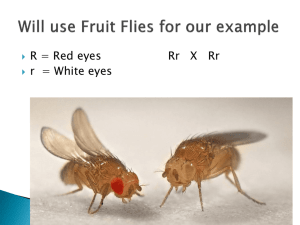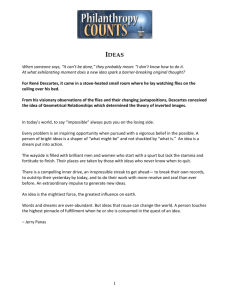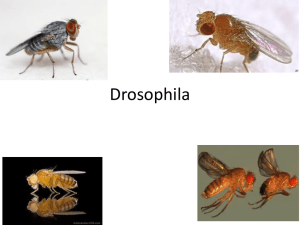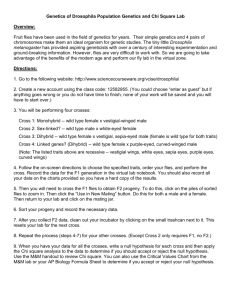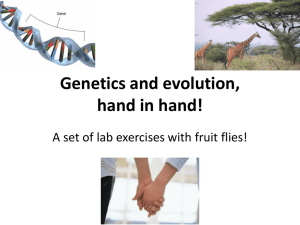drosophila melanogaster mutations
advertisement
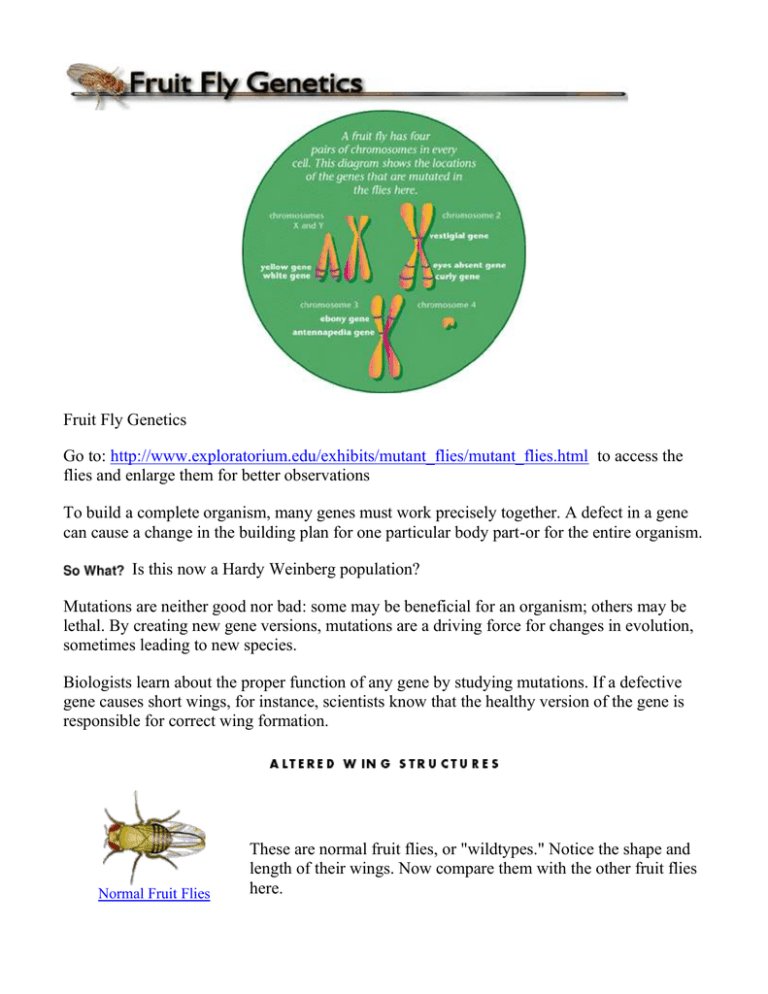
Fruit Fly Genetics Go to: http://www.exploratorium.edu/exhibits/mutant_flies/mutant_flies.html to access the flies and enlarge them for better observations To build a complete organism, many genes must work precisely together. A defect in a gene can cause a change in the building plan for one particular body part-or for the entire organism. Is this now a Hardy Weinberg population? Mutations are neither good nor bad: some may be beneficial for an organism; others may be lethal. By creating new gene versions, mutations are a driving force for changes in evolution, sometimes leading to new species. Biologists learn about the proper function of any gene by studying mutations. If a defective gene causes short wings, for instance, scientists know that the healthy version of the gene is responsible for correct wing formation. Normal Fruit Flies These are normal fruit flies, or "wildtypes." Notice the shape and length of their wings. Now compare them with the other fruit flies here. Short-Winged Flies Curly-Winged Flies Notice the shortened wings of these flies. Flies with vestigial wings cannot fly: they have a defect in their "vestigial gene," on the second chromosome. These flies have a recessive mutation. Of the pair of vestigial genes carried by each fly (one from each parent), both have to be altered to produce the abnormal wing shape. If only one is mutated, the healthy version can override the defect. Notice the curled wings of these flies. They have a defect in their "curly gene," which is on the second chromosome. Having curled wings is a dominant mutation, which means that only one copy of the gene has to be altered to produce the defect. In fact, if both copies are mutated, the flies do not survive. These normal fruit flies, or "wildtypes," have black-and-tan striped bodies. Compare them with the other fruit flies here. Normal Fruit Flies Notice that these flies are yellower than normal flies. They have a defect in their "yellow gene," which is on the X chromosome. Since the yellow gene is needed for producing a fly's normal black pigment, yellow mutant flies cannot produce this pigment. Yellow Flies Ebony Flies Notice that these flies have a dark, almost black, body. They carry a defect in their "ebony gene," on the third chromosome. Normally, the ebony gene is responsible for building up the tancolored pigments in the normal fruit fly. If the ebony gene is defective, the black pigments accumulate all over the body. These are normal fruit flies, or "wildtypes." Notice that their eye color is bright red. Compare them with the other fruit flies here. Normal Fruit Flies Notice that these flies have orange eyes. They have a defect in their "white" gene, which normally produces the red pigments in the eye. In these flies, the white gene only works partially, producing fewer red pigments than it should. Orange-Eyed Flies These flies have white eyes. Like the orange-eyed flies, they also have a defect in their "white" gene. But in these flies, the white gene is totally defective: it produces no red pigment at all. White-Eyed Flies These are normal fruit flies, or "wildtypes." Notice the antennas sticking out in front of their red eyes. Compare these flies to the other fruit flies here. Normal Fruit Flies Notice that these flies have no eyes. They have a defect in their "eyes absent" gene, which normally instructs cells in the larvae to form an eye. Eyeless Flies Leg-Headed Flies Notice that these flies have abnormal, leg-like antennas on their foreheads. They have a defect in their "antennapedia" gene (Latin for "antenna-leg"), which normally instructs some body cells to become legs. In these flies, the antennapedia gene falsely instructs cells that would normally form antenna to become legs instead. Mutant Fruit Flies (and other aspects of "Diving Into the Gene Pool") were made possible through support by the United States Department of Energy, Office of Energy Research. Complete the three virtual fly crosses, fill in data sheet Data Page Prelab Questions (read main page) 1. Why are fruit flies a good subject for genetic studies? 2. Describe the life cycle of Drosophila melanogaster 3. What tools would you need to study fruit flies in the lab? 4. Show the abbreviations that would be used to denote a fly with dumpy (dp) wings and a wild type fly that is carrying the allele for dumpy wings. The allele is not located on the sex chromosome. Sexing Fruit Flies 1. Describe the differences between male fruit flies and female fruit flies. 2. How many male fruit flies were present in the simulation? ______ How many females? ______ Cross 1: Wild Type Female x Vestigial Winged Male F1 Generation F2 Generation Wild Type Males Vestigial Winged Males Wild Type Females Vestigial Winged Females Hypothesis: What is the genotype of the parents and how is vestigial wings inherited (autosomal or sex linked) Chi Square Analysis Cross 2: White Eyed Female x Wild Type Male F1 Generation F2 Generation Wild Type Males White eyed Males Wild Type Females White Eyed Females Hypothesis: What is the genotype of the parents and how is eye color inherited (autosomal or sex linked) Chi Square Analysis Cross 4: Wild Type Female x Sepia Eyed, Vestigial Winged Male F1 Generation Wild Type Males Wild Type Female Total Wild Types Vestigial Winged Males (normal antenna) Vestigial Winged Females (normal antenna) Total Vestigial Winged (normal antenna) Aristapedia Males (normal wings) Aristapedia Females (normal wings) Total Aristapedia (normal wings) Vestigial Wings, Aristapedia Males Vestigial Wings, Aristapedia Females F2 Generation Total Vestigial Wings, Aristapedia Hypothesis: What is the genotype of the parents and how is aristapedia and vestigial wings inherited (autosomal or sex linked) Chi Square Analysis 1.) 2.) 3.) Need more examples go to http://biotech.gsu.edu/houghton'04/2107'15/lecture12.html



